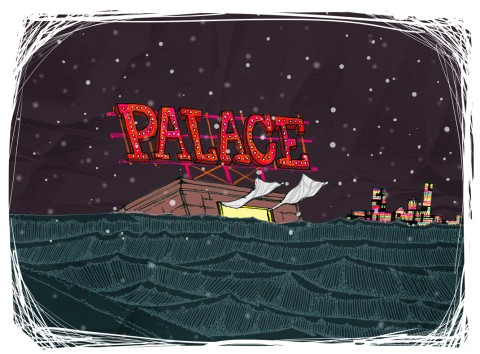
The following review is part of SmokeLong’s 20th-anniversary series looking back at beloved narratives in our archive. If you write reviews and you want to celebrate a particular narrative from the past 20 years of SmokeLong, dive into our archive and send us a review through Submittable. We pay a small honorarium for accepted pieces.
________________________
by Matt Kendrick
In The Art of Time in Fiction, Joan Silber states that “time draws the shapes of stories” (p3). A story is defined by (a) where it starts, (b) where it ends, and (c) the journey between those two points. Sometimes, that journey is simple. Other times, it is much more complex. And it seems to me that flash fiction is the perfect vessel for the most complex temporal journeys of all. So many brilliant flashes braid different time periods or fracture time into non-linear fragments, but one of my all-time favourites in terms of how it deals with time is ‘Wolf Cry’ by Sara Lippmann.
Its story is that of both a single evening and a whole lifetime. Hopping from present to distant past to recent past and back again, it inhabits different temporal modes (general / specific / habitual), and takes different approaches for orienting a reader on that journey. It is not a “classical” fracturing but one that layers present and past in order to mimic our narrator’s emotional turmoil and chime with the blizzard that blankets their world.
The quick shifting between time periods and temporal modes requires a clever architecture, a mesmerising understanding on Lippmann’s part of how to create a seamless flow. Take the transition between first paragraph and second paragraph, for example. The opening to the final sentence of the first paragraph is firmly in present tense—“It’s practically a blizzard”—but then we start to shift. We are given the image of a snow globe, which feels as though it has been chosen to do several things at once. It enhances the reader’s sense of atmosphere. But there is also something uncomfortable about it. There is a vast difference between the bitter cold of a blizzard and the magical artificiality of a snow globe, and it therefore acts as a stepping stone from realism to fabulism, working off other double-duty images earlier in the paragraph—the snowflakes are described as “perverse”, their uniqueness is described as “another fallacy”; the flickering of the “neon signs” also leans into that idea that something supernatural is at work. This is the feeling of a blizzard. But it is also the feeling of falling into memory.
At the start of the second paragraph, we are back in the past with “Once we lived like locals.” It isn’t the specific past—not yet. It is a habitual past. It is the next stepping stone towards the rich, specific memory. From there we travel into non-specifics, things that happened, the general summary of how it was the family first arrived. They rented somewhere to live. The father got a job. That job is then used as the pivot around which the paragraph shifts. It is the reason the family is able to go to “Harrah’s” on the night it opened. And from there we dive headlong into the specific memory in all its glory.
There is an elasticity to the way time works in this story. Silber talks about different categories of fictional time. We have “slowed time” which is perhaps where we find ourselves in the opening paragraph. Time has been paused so the scene can be described. Another of Silber’s categories is “classic time”, this is storytelling which “[relies] chiefly on scene, carefully interspersed with a little necessary summary”, and this perhaps is how we might describe that second paragraph. But there is a splinter of a sentence right in the middle that exists outside that timeframe. Where does “Absence killed April” fit in? This is something that happens after the memory but before the present of the snowstorm. And this is really the crux of how time is explored in the piece—in many ways it defies categorisation. It sets up an expectation then skips away from it, keeping the reader on their feet.
The first two paragraphs suggest we might be following Alice Adams’s ABDCE structure of “Arrival, Backstory, Development, Climax, Ending.” This is used in so many stories (the structure of ‘Inheritance’ by Grace Q. Song, for example, might be described in this way). But in ‘Wolf Cry’, Lippmann continues to keep a reader guessing. Rather than moving straight from the backstory into the present scene, we segue through interior thought (the questions and statements of the third paragraph) and only in the fourth paragraph are we firmly back with the snowstorm, but even then only for three sentences before we start shifting into memory once more.
Back and forth, back and forth—Lippmann walks a tight rope between pushing the time shifts too much and not making the most of their potential. The opening third serves as set-up not just to the narrative / characters, but also to how the story is going to be told. A reader is shown the rules and once the rules are established, Lippmann starts to break them. Most of the time jumps are preceded by some form of tethering (“When we lived here” / “Before she died”) but other moments are intentionally jolting. There is a scintillating moment in the sixth paragraph where we shift firmly into what Silber would call “fabulous time”—the narrator thinks of strawberries and, just like that, the strawberries have magically arrived.
It is this pushing of form to its outer limits that, for me, gives the story its power. Time is untethered but in a way that has such a well-thought-through design. A reader is disoriented but not so much that they are completely cut loose. And the clever temporal fracturing leaves a reader having experienced our narrator’s emotional journey in a way we might not have felt in a more linear approach.
For me, the beauty here is that Lippmann has created a chiming between narrative, setting, character and form. The story gains much of its power from the experimental way she has taken time and rendered it as a snowstorm.
Read ‘Wolf Cry’ by Sara Lippmann in Issue 33 of SmokeLong Quarterly.
______________________
 Matt Kendrick is a writer, editor and teacher based in the East Midlands, UK. His work has been featured in various journals and anthologies including Craft Literary, Best Microfiction, and The Best Small Fictions. Website: www.mattkendrick.co.uk | Twitter: @MkenWrites
Matt Kendrick is a writer, editor and teacher based in the East Midlands, UK. His work has been featured in various journals and anthologies including Craft Literary, Best Microfiction, and The Best Small Fictions. Website: www.mattkendrick.co.uk | Twitter: @MkenWrites

 The core workshop of SmokeLong Fitness is all in writing, so you can take part from anywhere at anytime. We are excited about creating a supportive, consistent and structured environment for flash writers to work on their craft in a community. We are thrilled and proud to say that our workshop participants have won, placed, or been listed in every major flash competition. Community works.
The core workshop of SmokeLong Fitness is all in writing, so you can take part from anywhere at anytime. We are excited about creating a supportive, consistent and structured environment for flash writers to work on their craft in a community. We are thrilled and proud to say that our workshop participants have won, placed, or been listed in every major flash competition. Community works.